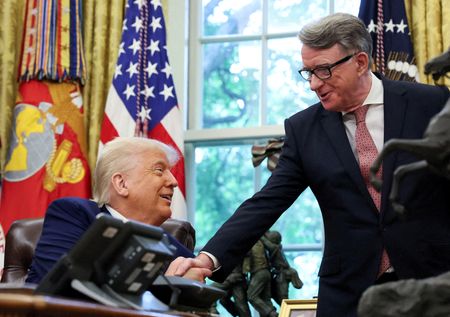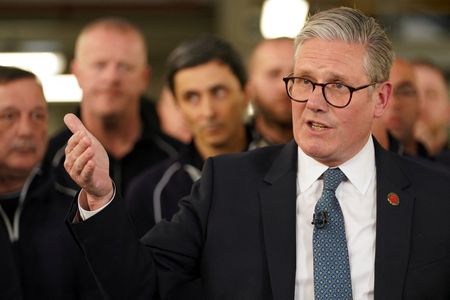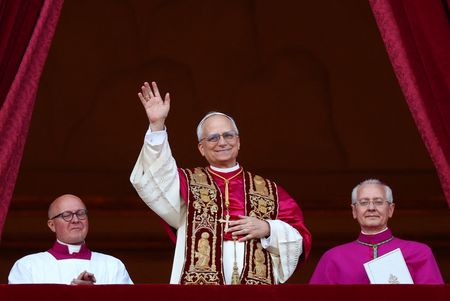By David Milliken, Suban Abdulla and William Schomberg
LONDON (Reuters) -The Bank of England cut interest rates on Thursday to tackle the expected hit from U.S. President Donald Trump’s tariffs but a surprise three-way split among policymakers cooled expectations that it might speed up future moves.
The BoE’s rate-setters voted 5-4 in favour of cutting borrowing costs by quarter of a percentage point to 4.25%.
Two Monetary Policy Committee members, Swati Dhingra and Alan Taylor, voted for a bigger half-point cut. Chief Economist Huw Pill and Catherine Mann wanted to keep rates on hold.
No economist polled by Reuters had expected any vote against a rate cut. Sterling rose and two-year borrowing costs jumped as markets saw a much reduced chance of another rate cut in June.
Thursday’s decision was the British central bank’s first since Trump announced wide-ranging tariffs on April 2, which unleashed temporary market turmoil and prompted the International Monetary Fund to cut its global growth forecasts.
The BoE said it thought tariff increases by the U.S. and other countries would trim British economic growth and push down on inflation, but stressed the outlook was unclear.
“The past few weeks have shown how unpredictable the global economy can be. That’s why we need to stick to a gradual and careful approach to further rate cuts,” Governor Andrew Bailey said.
The BoE has now cut interest rates by the same amount as the U.S. Federal Reserve since mid-2024 but by less than the European Central Bank due to concerns about high wage growth as well as the risk of persistently above-target inflation.
“The two votes from committee members to hold rates steady sent a more hawkish message to the market,” said Matthew Landon, global market strategist at J.P. Morgan Private Bank. “Beneath the hood, we still think that the conditions for cuts remain in place.”
NO ‘AUTOPILOT’ FOR RATES
The BoE said it had no pre-set path for rates. It also said the impact of global trade tensions “should not be overstated”.
“Interest rates are not on autopilot. They cannot be,” Bailey told a press conference. “Instead, the MPC must continue to respond carefully to the evolving economic circumstances.”
For three of the five policymakers who voted for a quarter-point reduction, this week’s decision would have been “finely balanced” without the escalation of trade tensions, the minutes showed. Bailey indicated to reporters he was among that group.
Based on the situation as of April 29, the BoE estimated the U.S. tariffs would lower British inflation by 0.2 percentage points in two years’ time and reduce the size of the economy by 0.3% after three years.
Later on Thursday, Trump said he would scrap 25% tariffs on imports of British steel and lower tariffs on cars from 27.5% to 10%, the rate which will remain for most other goods imports.
Bailey, speaking before details of the deal were public, said it would “help to reduce uncertainty”.
However, the BoE said about two-thirds of its forecast hit to British growth was due to the broader effects of tariffs on the world economy.
On Wednesday, Fed Chair Jerome Powell highlighted ongoing uncertainty about the impact of trade policy on the economy as the U.S. central bank held off from a further rate cut.
INFLATION FORECAST CUT
While investors still expect the BoE to lower interest rates close to 3.5% by year-end, June’s meeting now looks much less likely to yield a cut – with the probability falling to under 20% from around 60% before Thursday’s announcement.
Two-year gilt yields rose around 7 basis points after the BoE announcement and finished the day 12 bps higher at a two-week high of 3.93% as investors digested the U.S. deal.
Asked by CNBC television about the market reaction to the rate cut, Bailey said it reflected how the BoE had said there were still upside as well as downside risks to inflation.
In a quarterly forecast update, the BoE trimmed its expectation for inflation this year, seeing it peaking at around 3.5%, lower than a previous forecast of around 3.75% though up from the latest official reading of 2.6% in March.
It sees inflation back at its 2% target in the first quarter of 2027 – nine months earlier than it forecast in February.
The central bank expects the economy to grow this year by 1%, a bit more than February’s forecast of 0.75%, thanks to a strong end to 2024 and robust official data at the start of 2025 which pointed to 0.6% quarterly growth in the first quarter.
However, it said the first-quarter growth bounce looked like a one-off and for 2026 it cut its growth forecast to 1.25% from 1.5%.
(Addtional reporting by Andy Bruce; Writing by David Milliken and William Schomberg; Editing by Catherine Evans, Alexandra Hudson)











